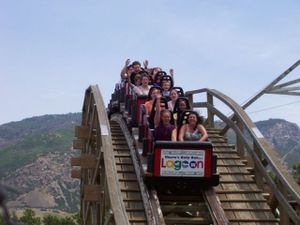Roller Coaster
Are you looking for some classic coaster thrills? If so then Lagoon's 'Roller Coaster is the perfect choice for you. Roller Coaster is Lagoon's classic double out and back wooden roller coaster that has been delighting park guests for more than 90 years and currently ranks as the 6th oldest roller coaster still in operation.[1]
History
Lagoon's Roller Coaster was designed by the legendary coaster designer John A. Miller, and constructed by Miller and Baker, Inc., a joint venture between John A. Miller and Harry C. Baker, another legendary coaster designer who designed and built the famous Coney Island Cyclone.
Roller Coaster opened on May 28, 1921, with at least one open front train, and quickly became one of the most popular rides at Lagoon. Roller Coaster has also had several names over it's more than 80 years at Lagoon. Some of those names were: Lagoon Dips or Pippen Dips, Lagoon Dipper, and Giant Coaster. Roller Coaster is also the Seventh Oldest Operating Roller Coaster in the World and Fifth Oldest Operating Roller Coaster in North America.
It is unknown when Lagoon's Roller Coaster was painted white, as it was the wood was left natural for several years. After the Fire of 1953, when the lift, station, and most of Lagoon was destroyed, Lagoon rebuilt the burned portions of the Roller Coaster and this is most likely when Lagoon purchased at least one Century Flyer Roller Coaster Train from National Amusement Device Co., (NAD) of Dayton, Ohio. The Century Flyer trains were often considered the best roller coaster trains of the day and featured a stainless steel skin with headlights on the front with a simple locking lap bar and padded seats.
It is not known when Lagoon replaced the NAD Century Flyer trains with the current Philadelphia Toboggan Company (PTC) 3 seat trains with one handrail (called buzz bars because of the buzzing sound they make when unlocked) per row. It is also unknown when Lagoon added a second train and switched from manual skid brakes to the modern fin brakes in use today. Lagoon did replace the buzz bars with individual ratcheting lap bars for 1990.
In 2001, Lagoon replaced the old Computer Controlled Safety System with a new PLC Safety System and also built and installed an all steel automatic transfer track. The old transfer track had to be manually moved into place, which made taking on or taking off a train time consuming. Now a train can be taken off or put on the transfer track in under 5 minutes.
In 2004, Lagoon posted signs in the queue line and around the fence in the parking lot stating that they were no longer going to paint the structure white, but let the ride return to it's natural brown color.
In 2008, Lagoon upgraded roller coaster's old PTC ratcheting lap bars, with a newer individual ratcheting lap bar from PTC, and installed what appeared to be an on board lap bar position safety system, much like the ones used on Wicked trains, on one train
In 2009, both trains had a grey box on the back of each car with 6 Green LED lights in 2 rows that light up when a lap bar is down. Lagoon also installed a new lighted sign for the ride, added rock work over the walls, and installed a small planter around the new sign.
Awards
American Coaster Enthusiasts Coaster Landmark Award -
The American Coaster Enthusiasts recognizes Lagoon Park's Roller Coaster as an ACE Roller Coaster Landmark, a designation reserved for rides of historical significance.
Originally named the Lagoon Dips or Pippen Dips, and later the Giant Coaster, the 62-foot tall double out-and-back ride was engineered by master designer John A. Miller (1874-1941) of the New York firm Miller & Baker, and built by the Colorado Construction Company. One of only 13 remaining examples of Miller's work worldwide, it was constructed at a cost of $75,000, and opened on May 28, 1921 with an initial drop of 57 feet and track length of 3,598 feet. An August 1923 flood damaged the structure requiring new concrete footings, and an eclectic new station was added following a November 1953 fire that damaged parts of the midway.
Representing Utah's only traditional wood coaster since 1958, its distinctive structure, stretching from the midway into the adjacent parking area, seems ideally set against the striking backdrop of the Wasatch Mountains. As the sixth oldest coaster in the world, Roller Coaster continues to thrill riders of all ages and remains an integral part of Lagoon's appealing collection of roller coasters.
Presented by American Coaster Enthusiasts - July 30, 2005
Lagoon placed the ACE Coaster Landmark Plaque on Roller Coaster's Exit Platform next to the Platform Exit in 2007.
Major Incidents
1934 - Ernest Henry Howe, age 20, of Ogden, Utah, died August 20, 1934, after attempting to stand up on top of the first hill.
1946 - James Young Hess, age 23, of Farmington, Utah, died September 01, 1946, from skull, leg, and internal injuries after being struck by a [roller coaster] car while working on the structure.[2]
1989 - Kilee King, age 13, of Bountiful, Utah, died June 09, 1989, after falling 35 ft from the front seat of a roller coaster train, restraint bar still locked in place. Investigation finds no criminal negligence on the part of Lagoon.[3]
Gallery
-
Old postcard showing Roller Coaster's original train and brown color.
Videos
References
- ↑ http://rollercoaster.wikia.com/wiki/Oldest_Roller_Coasters_in_Operation
- ↑ http://www.deseretnews.com/article/50767/BOUNTIFUL-GIRLS-DEATH-NOT-THE-1ST-ON-LAGOONS-WOODEN-ROLLER-COASTER.html
- ↑ http://www.deseretnews.com/article/50604/OFFICIALS-PROBING-DEATH-OF-GIRL-13-WHO-FELL-FROM-ROLLER-COASTER.html


